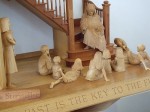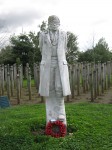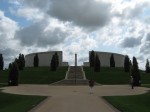 In the chapel at the National Memorial Arboretum is a delightful carving called the a story-teller which depicts a Christlike figure telling stories to an audience mainly of children. Most are rapt; one lad is leaning over the edge of the sculpture to investigate a snail crawling up the side (evidently what the child said when photgraphed in this pose!) The photo here I found online - the chapel was too crowded to get a photo today when I was there.
In the chapel at the National Memorial Arboretum is a delightful carving called the a story-teller which depicts a Christlike figure telling stories to an audience mainly of children. Most are rapt; one lad is leaning over the edge of the sculpture to investigate a snail crawling up the side (evidently what the child said when photgraphed in this pose!) The photo here I found online - the chapel was too crowded to get a photo today when I was there.
What struck me especially on this visit was the caption on the carving 'the past is the key to the future' - a statement filled with hope but I wondered how true the reality?
One of the most poignant for me is the Shot at Dawn memorial, where plain wooden stakes bear the names of men and boys executed for 'cowardice' in the first world war. It is set in a quiet part of the grounds, away from the main drag, where the sunlight first touches the arboretum. There is irony and beauty somehow mingled in this quiet space, where these men can be remembered.

If the past is the key to the future (and I have sympathy with the statement) then how so?
If this place can keep alive memories of the human cost of war, can help us to articulate and explore questions, then maybe it might be a more hopeful one.
A last thought. In the chapel the two 'thieves crosses' have hand cuffs dangling from them. Those of the 'good' thief are open, symbolising his freedom through Christ. For the 'bad' thief, one is open and one closed - a deliberately ambiguous symbol that says (according to the guide who spoke) we don't know what happened to him, but like to hope that he was on his way to freedom. Somehow I reckon most of us are a bit like that - as Brian Wren expresses it 'half free, half bound by inner chains... yet seeking hope for humankind.' Evidently around 80,000,000 people died in wars/conflicts in the twentieth century... may this past be the key to a more hopeful future as we remember, and having remembered refuse to forget.